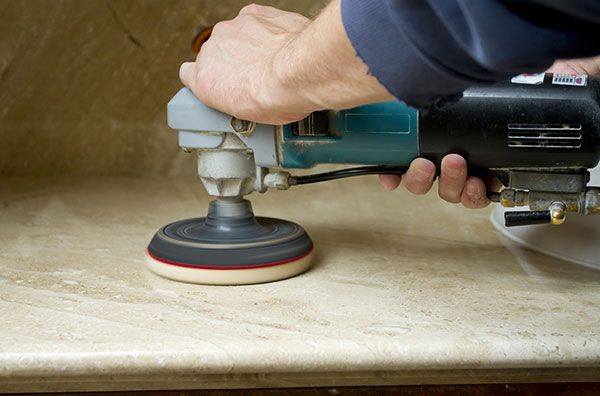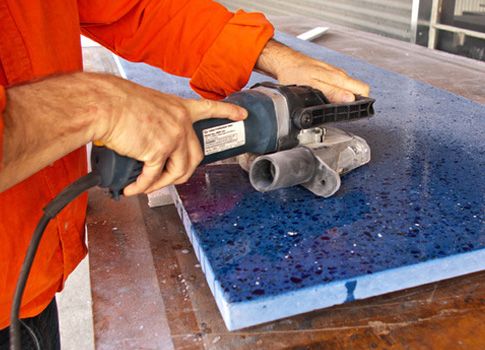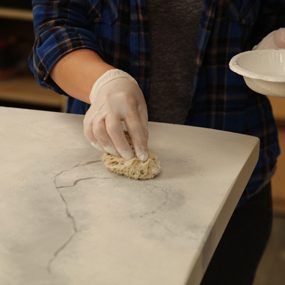Marble Restoration
in New York
Introduction to Marble Restoration
Marble restoration involves specialized techniques and processes to repair damage and deterioration in marble stone. Marble is prone to issues like cracking, dulling, and discoloration over time. Marble restoration breathes new life into aging marble by addressing these common problems.
Stone restoration as a whole covers restoration work done on various types of natural stone, including marble, granite, limestone, and others. Marble restoration is a specific branch of broader stone restoration work that deals exclusively with marble surfaces. Marble has distinct properties as a metamorphic stone that requires specialized restoration approaches.
The goal of any marble restoration project is to respect the integrity of marble stone while reviving its aesthetic appeal and structural stability and this is what Keystone Brownstone Restoration stands for.
Our Skilled marble restoration experts correctly assess flaws in marble and use the proper methods to resolve them. From polishing out scratches to patching cracks smoothly, Keystone Brownstone restoration returns beauty and functionality to damaged marble. This supports the continued use and enjoyment of historical and architectural marble artifacts for generations more.
Regular professional maintenance and cleaning can limit the extent of marble restoration needed. But marble restoration remains important for repairing unavoidable issues like etching and chipping that develop over decades of use.


Understanding Marble Damage
To understand what makes the facade of your building decline over time, you have to know the factors in play and the signs of deterioration.
Identifying Marble Imperfections
Marble is vulnerable to many imperfections over decades of use, requiring marble repair at some point. Common types of damage include etching, pitting, staining, cracking, dulling, and chipping.
The etching shows up as hazy cloudy areas on the surface. Pitting creates indented divots and holes. Staining and cracking both reduce the aesthetic appeal of pristine marble. Dull, scratched marble loses its reflective shine. Chipping occurs when pieces of the stone itself break off at edges or corners. Identifying the specific type of flaw is key for effective marble restoration.
Causes of Marble Deterioration
Marble deterioration is often caused by a range of environmental and usage-related factors that, over time, make professional restoration essential.
>Environmental Impact: Acid rain, mineral deposits from water exposure, and general weathering contribute to gradual surface erosion and discoloration in marble. These natural elements can compromise the marble’s strength and beauty, requiring timely intervention to prevent further damage.
>Daily Wear and Tear: Marble in high-traffic areas is subjected to continuous foot traffic, which gradually dulls its shine and may lead to subtle cracks, chips, or other signs of wear if not properly maintained. This wear and tear affects not only the aesthetic appeal but also the structural integrity of the marble.
>Improper Cleaning Practices: Using harsh chemicals or abrasive cleaning materials can severely damage marble, leaving it scratched, faded, or even etched. In these cases, extensive polishing and repair may be required to restore its natural beauty and finish.
By understanding these causes of marble deterioration, our restoration specialists can tailor repair and polishing techniques to each client’s needs.
Each site presents unique challenges, and our experts carefully analyze the marble’s condition to apply targeted, effective solutions, ensuring a flawless and enduring result that maintains the elegance and durability of the marble surface.

DIY Marble Polishing Tips
Home Marble Maintenance Tips
While minor marble cleaning can be done at home using gentle, pH-neutral cleaners, most marble damage requires specialized equipment and expertise for full restoration.
However, here are some simple maintenance tips to help retain marble’s polished shine between professional services:
- Use coasters under glasses and wipe spills promptly to prevent etching.
- Regularly sweep and mop floors to prevent abrasive grit from accumulating.
- Place mats at entryways to capture dirt and debris from shoes.
When signs of dullness, scratches, or staining appear, it’s best to contact a trusted marble restoration company rather than attempt DIY polishing methods. Professional restoration ensures a flawless finish and preserves the marble’s natural beauty, keeping it in optimal condition for years to come.
Professional Marble Restoration Services
True marble restoration involves customized techniques and advanced tools, which Keystone provides.
Our team of experts assesses the extent of staining, scratches, and other damage, creating a multi-step restoration plan that may include:
- Diamond Abrasive Honing – to precisely reshape and polish dulled marble surfaces.
- Epoxy Resin Injection – to stabilize existing cracks or new fractures.
- Expert Patching and Color Matching – to seamlessly restore damaged sections.
By evaluating each issue carefully and using specialized marble cleaning methods, our professionals can revive even the most lackluster, damaged marble. With extensive experience, we help clients maintain pristine marble for years.
Polishing Marble Surfaces
Polishing Marble Floors
Polishing marble floors involves a gradual restoration process to bring back smoothness and shine based on the level of dullness or scratches.
Key steps include:
- Deep cleaning the entire floor before beginning the polishing process.
- Assessing wear and determining the appropriate starting grit for polishing.
- Using a weighted floor polishing machine, moving methodically across the surface.
- Starting with 50-80 grit diamond polishing pads for heavy wear, progressing up to 3000 grit for the final polish.
- Repeating the polishing steps as needed to achieve the desired reflective shine.
- Applying a protective sealant to preserve the newly polished floor.
By following these best practices, professional contractors can effectively restore both domestic and commercial marble floors to a refreshed, radiant finish.
Countertop Polishing
Marble countertop restoration follows similar polishing principles, ensuring a smooth and gleaming surface.
Essential steps include:
- Clearing all items from the countertop before beginning the polishing.
- Identifying areas with etching, scratches, or discoloration for focused treatment.
- Working systematically in manageable sections across the countertop.
- Progressing through finer grit diamond polishing pads until achieving a consistent shine.
- Using specialty marble polishing compounds for stubborn etching or stains.
- Sealing the polished countertop to protect against common damage and prolong its pristine look.
With professional care and expertise, marble countertops can be restored to their original, elegant appearance through thorough and precise polishing techniques.
Marble Repair Solutions
Repairing Marble Chips
Chips, cracks, and missing fragments in marble can pose safety hazards and aesthetic concerns. Professional marble repair experts, like those at Keystone, employ several effective stone surface repair methods to flawlessly mend such damage:
- Thorough Cleaning: Remove loose debris and fragments from fractured areas to prepare for repair.
- Color-Matched Epoxy: Select an epoxy filler that closely matches the marble’s color, pattern, and texture.
- Incremental Rebuilding: Carefully rebuild missing sections for a smooth and even finish.
- Smoothing and Polishing: Profile, smooth, and polish the repaired area to seamlessly blend it into the surrounding surface.
With expert marble repair, even significant chips and cracks can completely “disappear” through careful application of color-matched epoxy stone surface repair techniques.
Removing Stains from Marble
Many DIY marble cleaning attempts fall short when it comes to removing set-in oil, dye, food, or other stubborn stains. Marble repair professionals possess specialized methods for stain removal that ensure optimal results:
- Identify the Stain: Determine the staining agent to choose the most effective removal approach.
- Targeted Application: Gently apply poultice or solvent agents specifically tailored to the type of stain present.
- Integrity Monitoring: Carefully monitor the marble’s integrity when using bleaching agents to avoid damage.
- Repetitive Treatment: Repeat stain removal attempts as necessary, followed by polishing to extract deep-set stains.
By thoroughly understanding various staining agents and marble’s inherent vulnerabilities, restoration artisans can implement customized repair techniques.
Most Common Questions
How to Polish Marble Floors?
- Assess floor damage/dullness to determine adequate starting grit pads
- Deep clean floors thoroughly before polishing
- Use a weighted rotational floor machine for even polishing
- Begin with 50-80 grit pads, progressing to 3000+ grit
- Lift and remove debris; change pads frequently
- Repeat as needed to restore shine
- Apply sealant after polishing for protection
What are the Best DIY Marble Cleaning Techniques?
- Dust mop floors frequently
- Immediately wipe spills using a soft pH-neutral cleaner
- Use microfiber cloths and avoid abrasive scouring pads
- Create a gentle cleaner solution of dish soap & warm water
- Rinse repeatedly to avoid streaks & residue
- Reseal if needed post-cleaning for stain protection
Can I Repair a Cracked Marble Countertop Myself?
- Professional repair is recommended for structural cracks
- Match color, finish, and veining to seamlessly blend epoxy
- Clean debris from crack thoroughly first
- Follow epoxy instructions precisely
- Allow proper hardening times before smoothing
- Re-polish the surface over the crack for an invisible patch
How to Remove Stains from Marble Surfaces?
- Identify a staining agent to customize the removal method
- pH-neutral gentle cleaners often ineffective on stains
- Tailored poultice pastes may lift stubborn stains
- May need to lightly hone & polish stained areas
- Avoid abrasive scouring that could scratch marble
- Seal after stain removal to boost protection
What are the Costs of Professional Marble Restoration Services?
- Range from $3-$10 per sq. ft. for floors
- Countertop rates around $100+ per linear ft.
- Chip and crack repair costs depend on the size
- Stain removal based on type severity & steps needed
- Request on-site quotes for exact project costs
Conclusion
Our comprehensive marble restoration services are carefully designed to bring back the original beauty and durability of your building’s marble surfaces. As part of our restoration process, we also provide thorough masonry cleaning to revitalize the appearance of your building and enhance its curb appeal.
Additionally, we ensure strict adherence to Local Law 11 requirements, so your property meets all necessary safety and regulatory standards. Our commitment to excellence in both marble restoration and masonry cleaning provides you with a complete and compliant restoration solution tailored to preserve and elevate your building’s aesthetic value.
